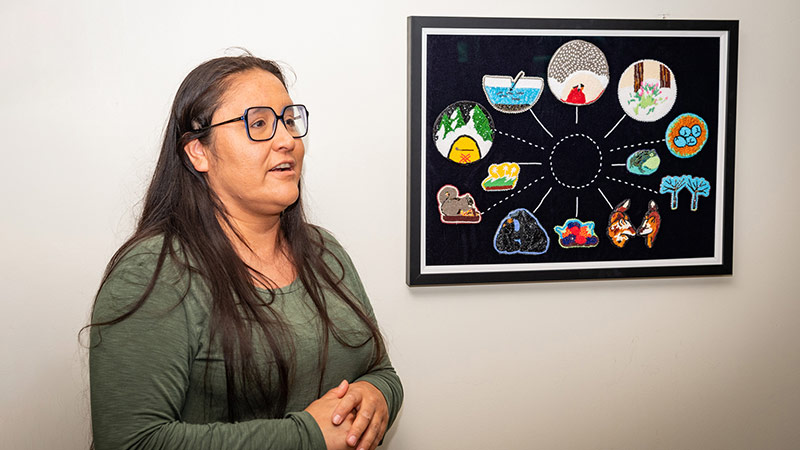Artworks celebrate the rich culture of Wolastoqiyik, Mi'kmaq and Peskotomuhkatiyik traditions
Author: Angie Deveau
Posted on Jul 26, 2023
Category: UNB Saint John

In a celebration of Indigenous culture, the University of New Brunswick (UNB) Saint John campus unveiled three artworks in Hazen Hall that pay homage to the rich heritage and distinct perspectives of the Wolastoqiyik, Mi'kmaq and Peskotomuhkatiyik nations.
The artworks were created by local Indigenous artists. They include: Wolastoq Song (painting), by Emma Hassencahl-Perley of Neqotkuk (Tobique First Nation); Kuhkumossonnuk (wampum belt), by Lisa-Maude Aubin-Berube of Wolastoqiyik Wahsipekuk (Viger); and Mi'kmaq Months, by Mi’kmaq Months (beaded art) by Ashley Sanipass of Indian Island First Nation.
Todd Ross, Indigenous advisor, and Genevieve Crowell, academic project specialist, created the call to artists and adjudicated the proposals.
During the unveiling event, Dr. Heidi MacDonald, the dean of arts on UNB's Saint John campus, highlighted Dorothy W. Legassick's generous bequest to the Lorenzo Society, a multi-disciplinary arts & culture organization that contributes to the intellectual and artistic life for students, faculty and staff, which made the event possible.
MacDonald said, "The artworks serve as a platform for Wabanaki perspectives to be heard and understood."
Sanipass attended the unveiling. She said her artwork invites viewers to appreciate Indigenous communities' intricate relationship with the natural world.
"It portrays the diversity and significance of the Mi'kmaq months, and it sheds light on the varying phases of the moon and their guidance in activities such as harvesting strawberries or hunting specific animals," said Sanipass.
As the owner of the Mi'kmaq Art Experience, Sanipass teaches people about art. Through her business, she allows participants to appreciate the beauty of the Mi'kmaq culture and gain a deeper understanding of their history and traditions.
Sanipass found inspiration for her artwork while hosting Mi'kmaq gatherings and learning the Mi'kmaq language. Georgina Barlow, an elder in Sanipass's community, introduced Sanipass to the Mi'kmaq months and their descriptions. Intrigued by the cultural knowledge embedded within these descriptions, Sanipass decided to create a project based on them.
“When I discovered the contest on the UNB Saint John campus, I knew it was an opportunity to showcase my work.”
The piece involved extensive beadwork and took about a month to create. She explained how the Mi'kmaq months vary depending on the territory and are intricately linked to the moon phases.
"While these months describe natural occurrences and events, the moon provides guidance on activities such as harvesting and hunting."
Sanipass attended the unveiling with her son. She was thrilled he was able to witness this momentous occasion.
“It was actually my first time I got to unveil something,” she said.
For Sanipass, the university's choice to feature a Mi'kmaq artist demonstrates its commitment to reconciliation efforts. She is pleased that her artwork will be put on display, enabling a wide audience to appreciate and engage with it.
Sanipass said she was proud to have her work selected. She believes art is therapeutic and is confident in its power to improve mental health.
“By sharing my culture and family stories through my artwork, I want to create meaningful connections and educate others about my heritage,” she said.
She said the exposure creates an opportunity for conversations between Indigenous and non-Indigenous students, faculty, and staff to foster a deeper understanding and appreciation of Mi'kmaq culture and language.
Sanipass hopes her artwork showcases the vibrant Mi'kmaq language. She wants to spark meaningful discussions about how it reflects the natural world.
“By emphasizing the importance of nature to the Mi'kmaq people's survival and mental well-being, I want to raise awareness about global warming and the urgent need to protect the environment.”
She believes art is a vital element of Indigenous advocacy and empowerment.
“Art has many uses and benefits,” she said. “It can bridge cultures and promote understanding.”
Sanipass hopes her work can help create more inclusive and equitable spaces
"Artists play a special role. It's something to appreciate and will be around for a long time for future generations to come."
